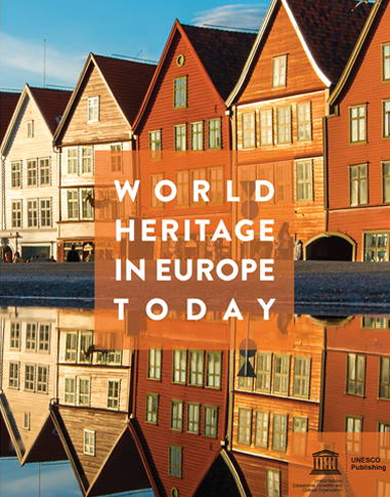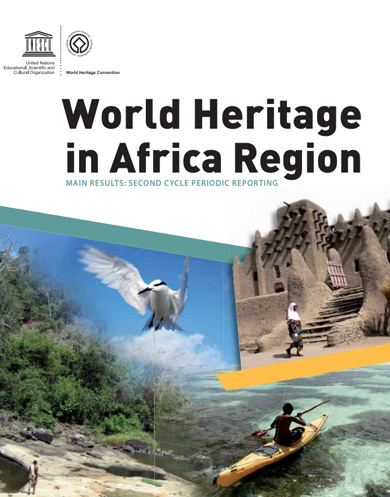Periodic Reporting
© UNESCO/Valentino Etowar
Access the questionnaire of
the Third Cycle of the Periodic Reporting
(2018-2024)
What is Periodic Reporting?
Periodic Reporting is one of the core conservation monitoring mechanisms of the World Heritage Convention. Every six years, the States Parties are invited to submit to the World Heritage Committee a Periodic Report on the application of the World Heritage Convention in their territory.
Article 29 of the World Heritage Convention
- The States Parties to this Convention shall, in the reports which they submit to the General Conference of the United Nations Educational, Scientific and Cultural Organization on dates and in a manner to be determined by it, give information on the legislative and administrative provisions which they have adopted and other action which they have taken for the application of this Convention, together with details of the experience acquired in this field.
- These reports shall be brought to the attention of the World Heritage Committee.
- The Committee shall submit a report on its activities at each of the ordinary sessions of the General Conference of the United Nations Educational, Scientific and Cultural Organization.
Operational Guidelines
Periodic Reporting is a self-reporting process and should be led as far as possible by the States Parties in each region. The Secretariat coordinates and facilitates the Periodic Reporting Process at the global level. States Parties may request expert advice from the Advisory Bodies and the Secretariat, which may also (with agreement of the States Parties concerned) commission further expert advice.
How does it work?
The World Heritage Committee has a regional approach to Periodic Reporting in order to promote regional collaboration and to be able to respond to the specific characteristics of each region.
Each year, State Parties of one of the five regions – the Arab States, Africa, Asia and the Pacific, Latin America and the Caribbean, and Europe and North America (in this order) – complete and submit both sections of the questionnaire.

The World Heritage Centre compiles regional reports from the data gathered and this is presented to the World Heritage Committee for examination and adoption. The World Heritage Committee also formulates recommendations to State Parties at the regional level, Action Plans are formulated through a collaborative process which often involves site managers, Advisory Bodies and the World Heritage Centre.
The process lasts for a period of approximately six years, and before the start of a new cycle, a Reflection period is initiated to evaluate the Periodic Reporting mechanism.
Periodic Reporting Cycles
Third Cycle (2018-2024)
The questionnaire for the Third Cycle of Periodic Reporting was revised within the framework of the Reflection on Periodic Reporting (2015-2017) and incorporates an extensive number of changes and improvements. As well as countless minor improvements, the major developments include full integration of the Sustainable Development approach, an emphasis on synergies with other conventions and programmes relevant to World Heritage and the creation of a monitoring indicator framework for the implementation of the World Heritage Convention. This new format was adopted by the World Heritage Committee at its 41st session in Krakow, Poland (2017).
| Region | Reporting period | Year of examination of Regional Report by the World Heritage Committee |
Number of States Parties |
|---|---|---|---|
| Arab States | 2018-2019 | 2020 2021 | 19 |
| Africa | 2019-2020 | 2021 | 46 |
| Asia and Pacific | 2020-2021 | 2022 | 44 |
| Latin America and the Caribbean | 2021-2022 | 2023 | 33 |
| Europe and North America | 2022-2023 | 2024 | 51 |
Second Cycle (2008-2015)
Two full cycles of Periodic Reporting have been implemented globally, Cycle I (2000-2006) and Cycle II (2008-2015). For more information on the First and Second Cycles specific to a certain region, please click on the links in the table.
| Region | Reporting period | Year of examination of Regional Report by the World Heritage Committee |
Number of States Parties |
|---|---|---|---|
| Arab States | 2008-2009 | 2010 | 18 |
| Africa | 2009-2010 | 2011 | 34 |
| Asia and Pacific | 2010-2011 | 2012 | 36 |
| Latin America and the Caribbean | 2011-2012 | 2013 | 32 |
| Europe and North America | 2012-2015 | 2014 (North America) 2015 (Europe) |
50 |
First Cycle (2000-2006)
Participation in Cycle 1
| Region | Reporting period | Year of examination Regional Report by the World Heritage Committee |
Number of States Parties involved |
|---|---|---|---|
| Arab States | 1998-1999 | 2000 | 18 |
| Africa | 1999-2000 | 2001 | 34 |
| Asia and Pacific | 2001-2002 | 2002 | 36 |
| Latin America and the Caribbean | 2002-2003 | 2003 | 28 |
| Europe and North America | 2003-2004 | 2005 (North America) 2006 (Europe) |
50 |
Regional Reports
and Action Plans
Regional
Reports
Having undergone the Periodic Reporting Process, a final report for each Region is prepared for presentation to the World Heritage Committee. The final report forms the baseline for the development of targeted Action Plans at national and regional levels, which respond to the needs, challenges, threats, strengths and opportunities identified and presented as a result of the Periodic Reporting exercise.
Action
Plans
Action Plans are a tool for setting regional priorities for implementing the World Heritage Convention. It is a way of interpreting and translating the Periodic Reporting data into concrete goals following a set timeline. Site manager and focal point can use the Action Plan to guide, inspire and inform their World Heritage-related work.
Action Plans are formulated through a collaborative process that can involve national focal points, site managers, Advisory Bodies and the World Heritage Centre. From this perspective, the action plan is a user-generated tool that incorporates the specific needs of Site Managers and States Parties.
Periodic Reporting Reflections
After each Periodic Reporting cycle, a period for reflection and evaluation is initiated allowing the periodic reporting mechanism to be assessed and revised as appropriate before a new cycle is initiated. Following the previous two cycles, the process and format of the exercises were revised and updated in the framework of Reflection Periods. The most recent of these was carried out from 2015-2017 and has resulted in a fully revised and updated questionnaire as well as reinforced tools and guidance to support capacity building for Periodic Reporting on the World Heritage Convention.
For more information on how the Periodic Reporting exercise evolved through these Reflection Periods please consult the following pages.
Activities (14)
- LAC Action Plan
- Periodic Reporting 1st Cycle: Africa
- Periodic Reporting 1st Cycle: Arab States
- Periodic Reporting 1st Cycle: Asia & Pacific (2003)
- Periodic Reporting 1st Cycle: Europe and North America
- Periodic Reporting 1st Cycle: Latin America and the Caribbean (2004)
- Periodic Reporting 2nd Cycle : Latin America and the Caribbean (2013)
- Periodic Reporting 2nd Cycle: Africa (2011)
- Periodic Reporting 2nd Cycle: Arab States (2010)
- Periodic Reporting 2nd Cycle: Asia & Pacific (2012)
- Periodic Reporting 2nd Cycle: Europe and North America region (2012-2015)
- Reflection Period (2015-2017) after the Second Cycle of Periodic Reporting
- Reflection year after the First Cycle of Periodic Reporting
- Support for the Second Cycle of the Periodic Reporting for Africa
News (11)
- UNESCO WHC, field offices and AWHF map future for World Heritage and Priority Africa in the region 23-Nov-2020
- Asia and the Pacific: Launch of the Third Cycle of Periodic Reporting Exercise 01-Oct-2020
- Third Cycle of the Periodic Reporting Exercise kicks off in Africa 11-Sep-2019
- World Heritage Site Managers of the Arab States Region Meet for a Workshop on Periodic Reporting 10-Apr-2019
- National Focal Points of the Arab States Region Meet for Periodic Reporting Workshop 11-Mar-2019
- World Heritage National Focal Points of the Arab States Region meet for Periodic Reporting Workshop 29-Nov-2018
- The Arab States region starts the Third Cycle of the Periodic Reporting exercise 18-Sep-2018
- World Heritage Committee launches Third Cycle of Periodic Reporting 24-Oct-2017
- Completion of the Testing Phase of the Revised Format of the Periodic Reporting Questionnaire 28-May-2017
- Official Launch of the Helsinki Action Plan Monitoring Survey 17-Oct-2016
Events (18)
- Periodic Reporting in Africa: Online Workshop on Data Analysis and Report Synthesis 28-Oct-2020-30-Oct-2020
- Periodic Reporting in Asia and the Pacific - Preparatory Online Consultation 03-Sep-2020-03-Sep-2020
- Third Cycle Periodic Reporting: Training Workshop for Anglophone World Heritage Site Managers in Nairobi 19-Feb-2020-22-Feb-2020
- Invitation: Periodic Reporting - A Collaborative Implementation in Africa 05-Jun-2019-05-Jul-2019
- Meeting of Arab States World Heritage Site Manager in Manama in the framework of Periodic Reporting 29-Apr-2019-01-May-2019
- Periodic Reporting in Europe and North America: Follow-up activities to the Helsinki Action Plan 15-Jul-2016-15-Jul-2016
- Towards an Action Plan for World Heritage in Latin America and the Caribbean 2014-2024 23-Apr-2014-25-Apr-2014
- Final Meeting of the Second Cycle of the Periodic Reporting Exercise for Latin America and the Caribbean, 3-5 December 2012, Santiago, Chile 02-Dec-2012-05-Dec-2012
- Workshop on management for World Heritage site managers in South-Eastern Europe in the framework of the preparation of the Second Cycle of Periodic Reporting for Europe and North America 12-May-2012-15-May-2012
- Sub-Regional Meeting for Central America, Second Cycle of the Periodic Reporting Exercise for Latin America and the Caribbean, Zacatecas, Mexico 12-Mar-2012-14-Mar-2012











